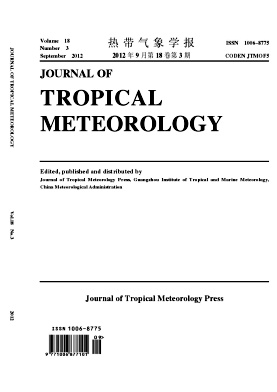|
[1]
|
KLINK K. Trends and interannual variability of wind speeddistributions in Minnesota [J]. J. Climate, 2002, 15: 3311-3317. |
|
[2]
|
JIMÉNEZ P A, GONZáLEZ-ROUCO J F, MONTáVEZ JP, et al. Surface wind regionalization in complex terrain [J]. J.Appl. Meteor. Climatol., 2008, 47: 308-325. |
|
[3]
|
JIMÉNEZ P A, GONZáLEZ-ROUCO J F, MONTáVEZ JP, et al. Climatology of wind patterns in the northeast of theIberian Peninsula [J]. Int. J. Climatol., 2009, 29: 501-525. |
|
[4]
|
WAN H, WANG X L, SWAIL V R. Homogenization andtrend analysis of Canadian near-surface wind speeds [J]. J.Climate, 2010, 23: 1209-1225. |
|
[5]
|
RIFE D L, DAVIS C A, LIU Y B, et al. Predictability oflow-level winds by mesoscale meteorological models [J]. Mon.Wea. Rev., 2004, 132: 2533-2569. |
|
[6]
|
ŽAGAR N, ŽAGAR M, CEDILNIK J, et al. Validation ofmesoscale low-level winds obtained by dynamical downscalingof ERA40 over complex terrain [J]. Tellus, 2006, 58A:445-455. |
|
[7]
|
JIMÉNEZ P A, GONZÁLEZ-ROUCO J F,GARCíA-BUSTAMANTE E, et al. Surface windregionalization over complex terrain: Evaluation and analysisof a high-resolution WRF simulation [J]. J. Appl. Meteor.Climatol., 2010, 49: 268-287. |
|
[8]
|
LUDWIG F L, MILLER D K, GALLAHER S G.Evaluating a hybrid prognostic-diagnostic model that improveswind forecast resolution in complex coastal topography [J]. J.Appl. Meteor. Climatol., 2006, 45: 155-177. |
|
[9]
|
CHANDRASEKAR A, PHILBRICK C R, CLARK R, et al.Evaluating the performance of a computationally efficientMM5/CALMET system for developing wind field inputs to airquality models [J]. Atmos. Environ., 2003, 37: 3267-3276. |
|
[10]
|
JACKSON B, CHAU D, GURER K, et al. Comparison ofozone simulations using MM5 and CALMET/MM5 hybridmeteorological fields for the July/August 2000 CCOS episode[J]. Atmos. Environ., 2006, 40: 2812-2822. |
|
[11]
|
YIM S H L, FUNG J C H, LAU A K H, et al. Developinga high-resolution wind map for a complex terrain with acoupled MM5/CALMET system [J]. J. Geophys, Res., 2007,112:D05106. doi:10.1029/2006JD007752. |
|
[12]
|
SKAMAROCK W C, KLEMP J B, DUDHIA J, et al. Adescription of the advanced research WRF version 3 [R]. 2008,NCAR Tech. Note TN-475 +STR, 125pp. |
|
[13]
|
POWERS J G. Numerical prediction of an Antarctic severewind event with the Weather Research and Forecasting (WRF)model [J]. Mon. Wea. Rev., 2007, 135: 3134-3157. |
|
[14]
|
DAVIS C, WANG W, CHEN S S, et al. Prediction oflandfalling hurricanes with the advanced hurricane WRF model[J]. Mon. Wea. Rev., 2008, 136: 1990-2005. |
|
[15]
|
BAO J W, MICHELSON S A, PERSSON P O G, et al.Observed and WRF-simulated low-level winds in a high-ozoneepisode during the Central California Ozone Study [J]. J. Appl.Meteor. Climatol., 2008, 47: 2372-2394. |
|
[16]
|
BUKOVSKY M S, KAROLY D J. Precipitationsimulations using WRF as a nested regional climate model [J].J. Appl. Meteor. Climatol., 2009, 48: 2152-2159. |
|
[17]
|
RUIZ J J, SAULO C, NOGUÉS-PAEGLE J. WRF modelsensitivity to choice of parameterization over South America:Validation against surface variables [J]. Mon. Wea. Rev., 2010,138: 3342-3355. |
|
[18]
|
HONG S Y, DUDHIA J, CHEN S H. A revised approachto ice microphysical processes for the bulk parameterization ofclouds and precipitation [J]. Mon. Wea. Rev., 2004, 132:103-120. |
|
[19]
|
KAIN J S. The Kain-Fritsch convective parameterization:An update [J]. J. Appl. Meteor., 2004, 43, 170-181. |
|
[20]
|
DUDHIA J. Numerical study of convection observedduring the Winter Monsoon Experiment using a mesoscaletwo-dimensional model [J]. J. Atmos. Sci., 1989, 46:3077-3107. |
|
[21]
|
MLAWER E J, TAUBMAN S J, BROWN P D, et al.Radiative transfer for inhomogeneous atmospheres: RRTM, avalidated correlated-k model for the longwave [J]. J. Geophys.Res., 1997, 102, 16663-16682. |
|
[22]
|
HONG S Y, NOH Y, DUDHIA J. A new vertical diffusionpackage with an explicit treatment of entrainment processes [J].Mon. Wea. Rev., 2006, 134: 2318-2341. |
|
[23]
|
PAN Z, TAKLE E, GUTOWSKI W, et al. Long simulationof regional climate as a sequence of short segments [J]. Mon.Wea. Rev., 1999, 127: 308-321. |
|
[24]
|
QIAN J H, SETH A, ZEBIAK S. Reinitialized versuscontinuous simulations for regional climate downscaling [J].Mon. Wea. Rev., 2003, 131: 2857-2874. |
|
[25]
|
LO J C F, YANG Z L, PIELKE R A. Assessment of threedynamical climate downscaling methods using the WeatherResearch and Forecasting (WRF) model [J]. J. Geophys. Res.,2008, 113:D09112. doi:10.1029/2007JD009216. |
|
[26]
|
SCIRE J S, ROBE F R, FERNAU M E, et al. A user’sguide for the CALMET meteorological model (version 5) [R].2000, Earth Tech, Inc., 332 pp. |
|
[27]
|
TAYLOR K E. Summarizing multiple aspects of modelperformance in a single diagram [J]. J. Geophys. Res., 2001,106: 7183-7192. |
|
[28]
|
MASS C F, OVENS D, WESTRICK K, et al. Doesincreasing horizontal resolution produce more skillful forecasts?[J]. Bull. Amer. Meteor. Soc., 2002, 83: 407-430. |
|
[29]
|
GHIL M, ALLEN M R, DETTINGER M D, et al.Advanced spectral methods for climatic time series [J]. Rev.Geophys., 2002, 40:1003. doi:10.1029/2000RG000092. |

















 粤公网安备 4401069904700002号
粤公网安备 4401069904700002号
 DownLoad:
DownLoad: